Vendor management challenges are frequently unresolved for too long.
Why? The simple answer is that vendor management is not valued by leadership staff. According to the authors of 2022 research from BCG staff, CEOs typically spend just 1% of their time interacting with suppliers. The reality is that they should spend more than 25% of their time with third parties.
Investing leadership’s time in third-party relations is worth it. When you look at the challenges of vendor management, it’s easy to see why. The vendor management process can be complex, fast-moving, and inefficient: yet with careful planning, the solutions can be easily achieved.
In this article, we will square up to those challenges as part of our cluster of articles on vendor management.
- We’ll start by reminding you why it’s so important to meet the challenges of vendor management.
- Then, we’ll dive into the nine big challenges facing any company with third-party suppliers.
- To round off, we’ll mention how to solve problems with a Vendor Management System (or VMS), one of the ways modern companies handle their vendors better.
Take a few moments to read this article and see what obstacles to avoid. You could make serious cost savings.
Why should you tackle vendor management challenges?
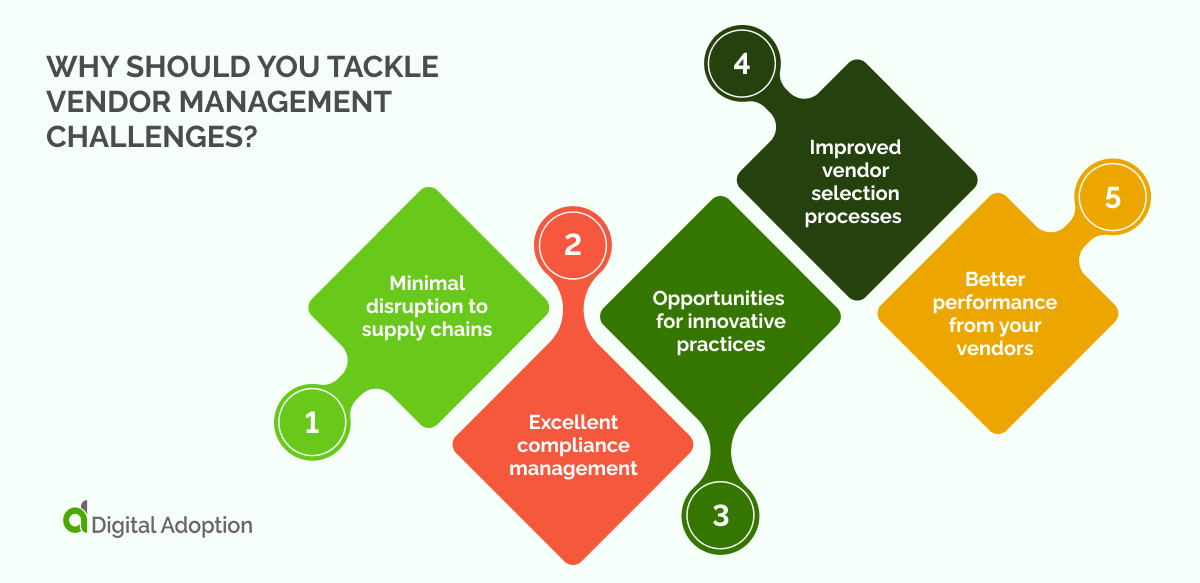
If you want to know why managing your vendor management effectively is important, just look at our article about vendor management benefits. In short, managing relationships well means that you should see:
- Minimal disruption to supply chains
- Excellent compliance management
- Opportunities for innovative practices
- Improved vendor selection processes
- Better performance from your vendors.
You can achieve a lot of value from good vendor management – even if it goes unnoticed so much of the time.
But like anything, you only get the benefits if you deal with the problems.
The top vendor management challenges
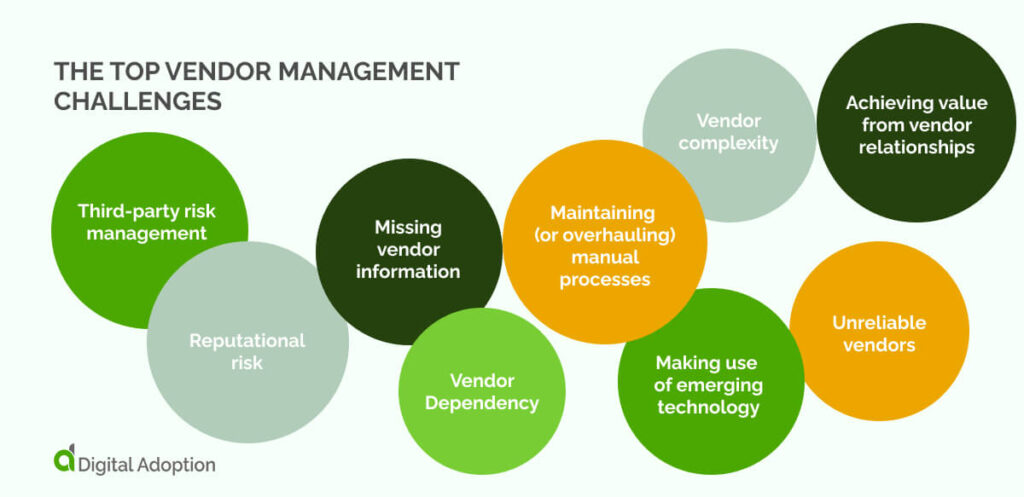
So – let’s take a closer look at the challenges of managing vendor relationships!
Of course, the challenges of vendor management will be different between organizations of various sizes, the number of vendors you use, the management style, and your business priorities.
However, some common challenges from many types of businesses include the following nine examples.
Third-party risk management
Risk assessments were never easy, but they’re getting harder than ever.
Gartner’s research explained how much more complicated risk had become.
It’s not easy to thoroughly identify and mitigate potential vendor risks. But doing this will ensure operational continuity, protect the reputation and customer trust, and comply with legal and regulatory requirements.
Reputational risk
Your company’s reputation comes with a different set of risks.
The public perception of your company may sometimes be at stake. Today, as the editors of a recent issue of Business and Society explained, “Any stakeholder can potentially damage corporate reputation.”
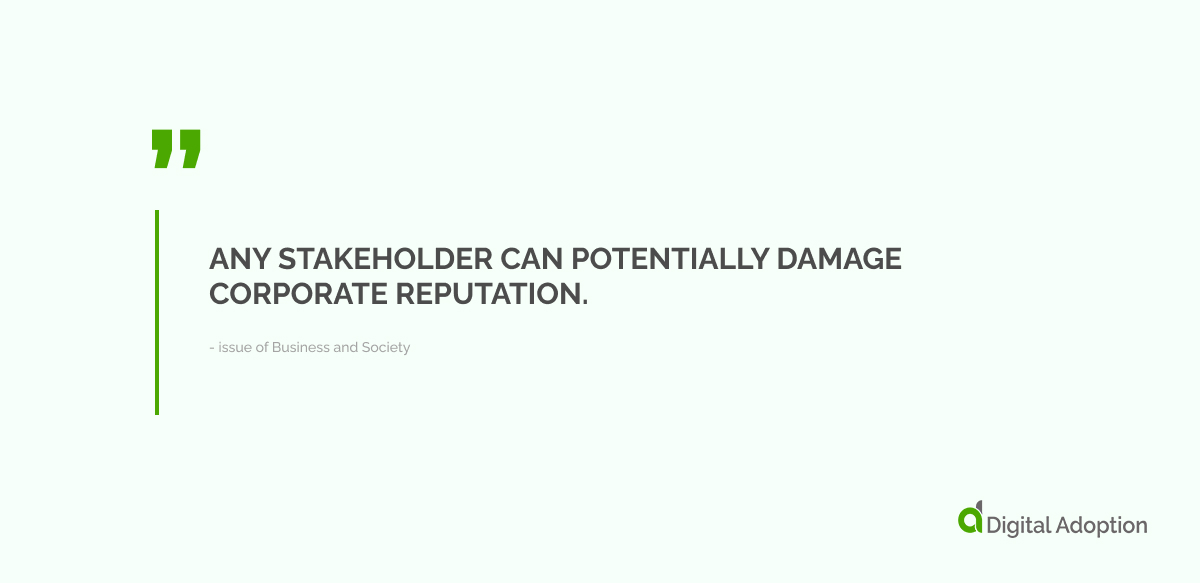
However, you also risk your company’s standing in the business community. If your network knows you don’t prioritize the best vendor management practices, you’ll find attracting and retaining the best suppliers and customers much harder.
Missing vendor information
The absence of crucial vendor information can create major headaches.
Comprehensive vendor details help companies to make informed decisions, assess vendor capabilities, and establish effective partnerships. Without the right information, every part of the relationship is impaired – from the selection process to contract negotiations to ongoing vendor performance monitoring.
Appropriate software can make it much easier to keep track of all the necessary information.
Maintaining (or overhauling) manual processes
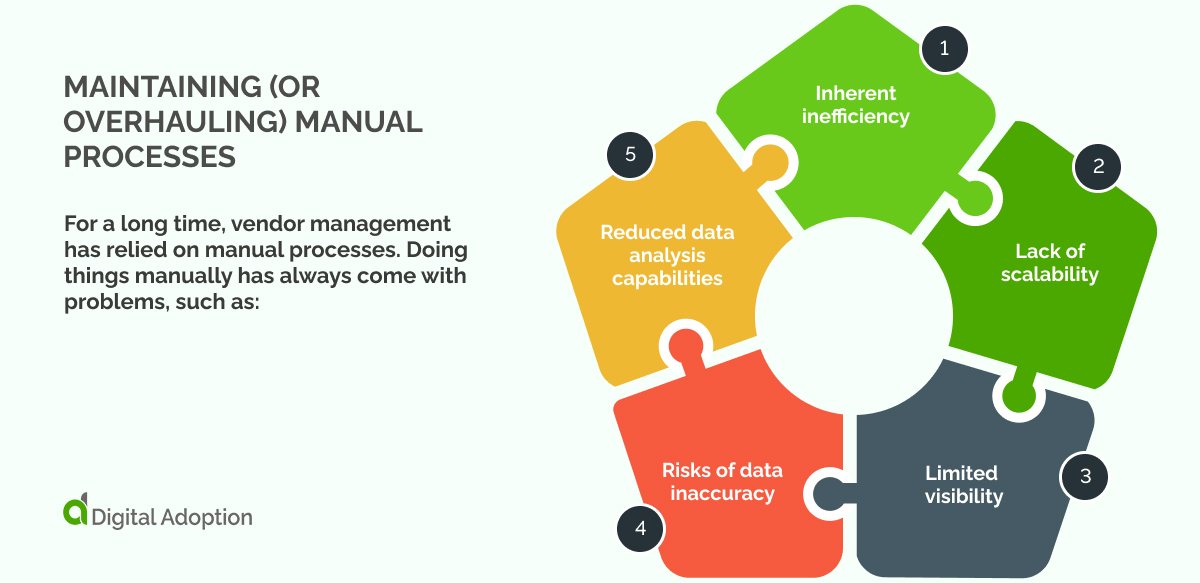
For a long time, vendor management has relied on manual processes. Doing things manually has always come with problems, such as:
- inherent inefficiency
- lack of scalability
- limited visibility
- risks of data inaccuracy
- reduced data analysis capabilities
Manual processes can become extremely difficult to maintain as your company grows and adapt.
Automating processes is the way forward, but it can become a major change management project. The complexity of data, integrating systems, and vendor cooperation can all make automation a major challenge.
In the end, adapting to digital vendor relationship management systems is the way to drive growth and profitability. It’s a job for a brave procurement leader!
Vendor Dependency
Relying heavily on a single vendor or a small number of vendors increases the organization’s vulnerability to supply chain disruptions, financial instability, or operational issues. Moreover, vendor options reduce the organization’s negotiating power, making securing favorable terms, pricing, and service-level agreements harder.
Diversifying vendor relationships and reducing dependency is essential for mitigating risks and ensuring a more robust and resilient vendor management strategy.
Vendor complexity
On the other hand, vendor relationships can become incredibly complex: especially when you depend on third-party companies to look after interlocking parts of your business. The challenges in IT are especially big, as it is so common to rely on a host of different providers.
Making use of emerging technology
As mentioned, software and automation can support many vendor management challenges.
However, using emerging technology can be a challenge in itself.
Naturally, vendor managers will want to use every available technique. But when new solutions arrive on the market, it may be difficult to see how they will work with your current vendor management processes.
Some of the major challenges include:
- Compatibility and integration
- Knowledge and expertise
- Cost, investment, and risk
- Data Security
It’s hard to build a culture of early adoption, but it can still lead to cost savings in the long run.
Unreliable vendors
There are plenty of bad vendor managers out there. But sadly, many vendors are also not up to scratch, creating serious problems for any company that wants to benefit from third-party services.
Unreliable vendors might delay delivery, betray your trust, under-deliver, and expose your company to even more risks. And depending on the services they offer – they may be hard to replace.
Achieving value from vendor relationships
Finally, achieving the right balance in a vendor relationship can be a real challenge.
Ken Kanara’s 2020 article for HBR explains the problem. On the one hand, companies must thoroughly screen and test vendors before committing. But on the other hand, those same companies might treat the vendors as ‘disposable’ once they are on board.
Kanara’s solution is to build close relationships with vendors, treating them more like employees.
Can a vendor management system meet your challenges?
If you want to meet your vendor management challenges, there are many practices you should try to implement – including better staffing, standardization of protocols, and strategic planning.
On top of these methods, a Vendor Management System can be a great way to improve things. A good VMC can support you with:
- Centralized Vendor Data
- Contract Management
- Performance Tracking and Metrics
- Workflow automation
- Data analysis
We’ve published a guide to leading vendor management software. Weight some options – this might be the difference between struggling and flying.
Maximize your vendor management process!
Vendor management might feel like an isolated niche. But let’s just remember the scale of costs involved. In IT alone, research from Gartner suggested that 62% of digital spending goes to third-party vendors. With so much at stake, the challenges are worth facing!
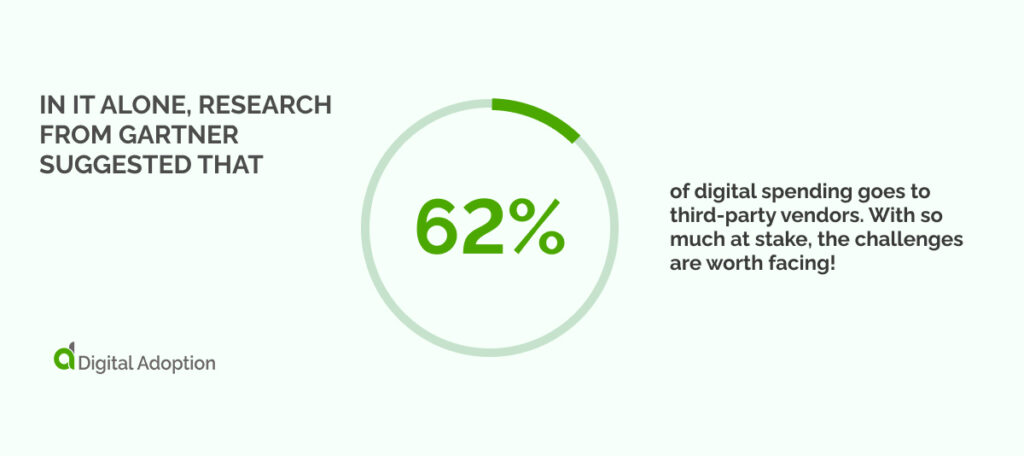
As we’ve seen in this article, facing up to your difficult vendor situations helps you realize the benefits of strong relationships – including better performance, enhanced efficiency, and a stable supply chain.
Some of the problems you might face along the way include risk management, process automation, and (sorry to say it!) unreliable vendors. A good vendor management system is a strong place to start if you want to set things straight.
Now that you know the most common vendor management challenges, there’s no good reason to ignore them.

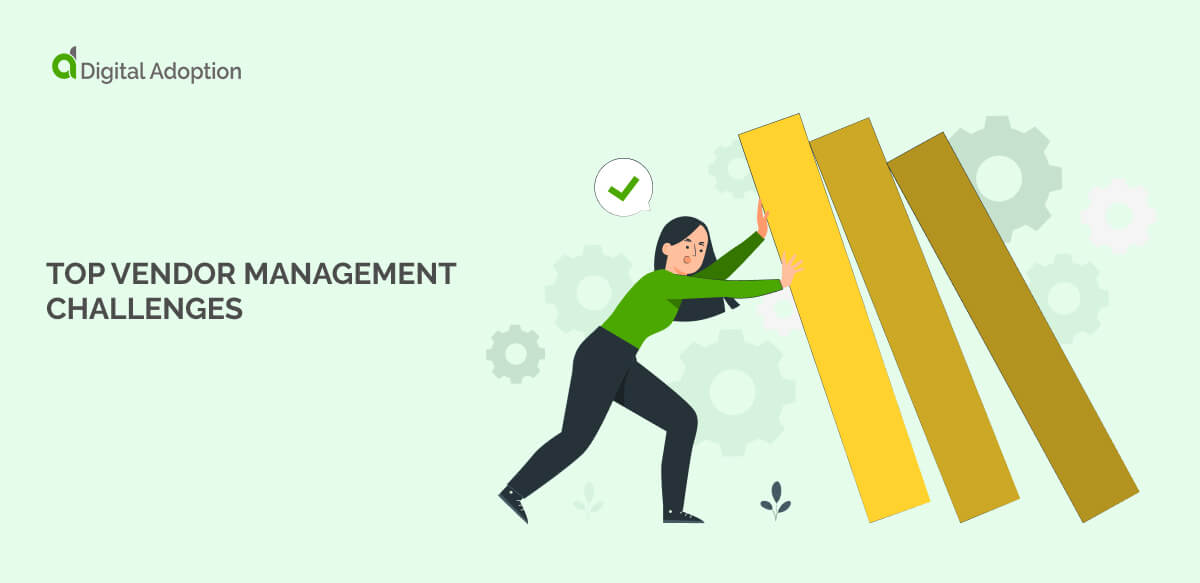


![4 Best AI Chatbots for eCommerce [2025]](https://www.digital-adoption.com/wp-content/uploads/2025/03/4-Best-AI-Chatbots-for-eCommerce-2025-img-300x146.jpg)


![13 Digital Transformation Enablers [2025]](https://www.digital-adoption.com/wp-content/uploads/2025/02/13-Digital-Transformation-Enablers-2025-img-300x146.jpg)



![4 Best AI Chatbots for eCommerce [2025]](https://www.digital-adoption.com/wp-content/uploads/2025/03/4-Best-AI-Chatbots-for-eCommerce-2025-img.jpg)

